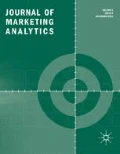Abstract
This study uses an eye-tracking method to explore the framing effect on observed eye movements and purchase intention in online shopping. The results show that negative framing induces more active eye movements. Function attributes and non-functionality attributes attract more eye movements and with higher intensity. And the scanpath on the areas of interest reveals a certain pattern. These findings have practical implications for e-sellers to improve communication with customers.


Similar content being viewed by others
Notes
The original language of the product information pages is Traditional Chinese.
References
Cheng, F.-F. and Wu, C.-S. (2010) Debiasing the framing effect: The effect of warning and involvement. Decision Support Systems 49 (3): 328–334.
Dunegan, K.J. (1993) Framing, cognitive modes, and image theory: Toward an understanding of a glass half full. Journal of Applied Psychology 78 (3): 491–503.
Ehmke, C. and Wilson, S. (2007) Identifying web usability problems from eye-tracking data. In HCI…but not as we know it. Proceedings of the 21st British HCI Group Annual Conference on People and Computers; 3–7 September, Lancaster, UK. Swinton, UK: British Computer Society, pp. 119–128.
Goldberg, J.H. and Kotval, X.P. (1999) Computer interface evaluation using eye movements: Methods and constructs. International Journal of Industrial Ergonomics 24 (6): 631–645.
Gonzalez, C., Dana, J., Koshino, H. and Just, M. (2005) The framing effect and risky decisions: Examining cognitive functions with fMRI. Journal of Economic Psychology 26 (1): 1–20.
Hartmann, J., Angeli, A.D. and Sutcliffe, A. (2008) Framing the User Experience: Information Biases on Website Quality Judgement. HCI 2008, Florence, Italy: ACM Press.
Howard, K. and Salkeld, G. (2009) Does attribute framing in discrete choice experiments influence willingness to pay? Results from a discrete choice experiment in screening for colorectal cancer. Value in Health 12 (2): 354–363.
Jacob, R.J.K. and Karn, K.S. (2003) Eye tracking in human-computer interaction and usability research: Ready to deliver the promises (Section Commentary). In: J. Hyona, R. Radach and H. Deubel (eds.) The Mind's Eye: Cognitive and Applied Aspects of Eye Movement Research. Amsterdam, the Netherlands: Elsevier Science.
Josephson, S. (2004) Eye tracking methodology and the Internet. In: K. Smith, S. Moriarty, G. Barbatsis and K. Kenney (eds.) Handbook of Visual Communication: Theory, Methods, and Media. London: Lawrence Erlbaum Associates.
Just, M.A. and Carpenter, P.A. (1976) Eye fixations and cognitive processes. Cognitive Psychology 8 (4): 441–480.
Just, M.A. and Carpenter, P.A. (1980) A theory of reading: From eye fixations to comprehension. Psychological Review 87 (4): 329–354.
Krishnamurthy, P., Carter, P. and Blair, E. (2001) Attribute framing and goal framing effects in health decisions. Organizational Behavior and Human Decision Processes 85 (2): 382–399.
Kuvaas, B. and Selart, M. (2004) Effects of attribute framing on cognitive processing and evaluation. Organizational Behavior and Human Decision Processes 95 (2): 198–207.
Levin, I.P. (1987) Associative effects of information framing. Bulletin of the Psychonomic Society 25 (2): 85–86.
Levin, I.P. and Gaeth, G.J. (1988) How consumers are affected by the framing of attribute information before and after consuming the product. Journal of Consumer Research 15 (3): 374–378.
Levin, I.P., Schneider, S.L. and Gaeth, G.J. (1998) All frames are not created equal: A typology and critical analysis of framing effects. Organizational Behavior and Human Decision Processes 76 (2): 149–188.
Meyerowitz, B.E. and Chaiken, S. (1987) The effect of message framing on breast self-examination attitudes, intentions, and behavior. Journal of Personality and Social Psychology 52 (3): 500–510.
Petty, R.E. and Cacioppo, J.T. (1986) Communication and Persuasion: Central and Peripheral Routes to Attitude Change. New York: Springer/Verlag.
Pieters, R. (2007) A review of eye-tracking research in marketing. Review of Marketing Research 4: 123–147.
Poole, A. and Ball, L.J. (2005) Eye tracking in human-computer interaction and usability research: Current status and future prospects. In: C. Ghaoui (ed.) Encyclopedia of Human Computer Interaction. Pennsylvania: Idea Group.
Rayner, K. (1998) Eye movements in reading and information processing: 20 years of research. Psychological Bulletin 124 (3): 372–422.
Rayner, K. (2009) Eye movements and attention in reading, scene perception, and visual search. Quarterly Journal of Experimental Psychology 62 (8): 1457–1506.
Tversky, A. and Kahneman, D. (1981) The framing of decisions and the psychology of choice. Science 211 (4481): 453–458.
Wu, C.-S. and Cheng, F.-F. (2011) The joint effect of framing and anchoring on internet buyers’ decision-making. Electronic Commerce Research and Applications 10 (3): 358–368.
Zhang, Y. and Buda, R. (1999) Moderating effects of need for cognition on responses to positively versus negatively framed advertising messages. Journal of Advertising 28 (2): 1–15.
Acknowledgements
Reprinted with permission, from IEEE January 2014, 47th Hawaii International Conference on System Sciences, ‘Effects of Attribute Framing Varying with the Elaboration in Online Shopping: An Eye-Tracking Approach,’ by S.F. Yang and H.H. Lin. The research is supported by the National Science Council of Taiwan under Contract number NSC101-2410-H-110-010-MY2.
Author information
Authors and Affiliations
Rights and permissions
About this article
Cite this article
Lin, HH., Yang, SF. An eye movement study of attribute framing in online shopping. J Market Anal 2, 72–80 (2014). https://doi.org/10.1057/jma.2014.8
Received:
Revised:
Published:
Issue Date:
DOI: https://doi.org/10.1057/jma.2014.8




